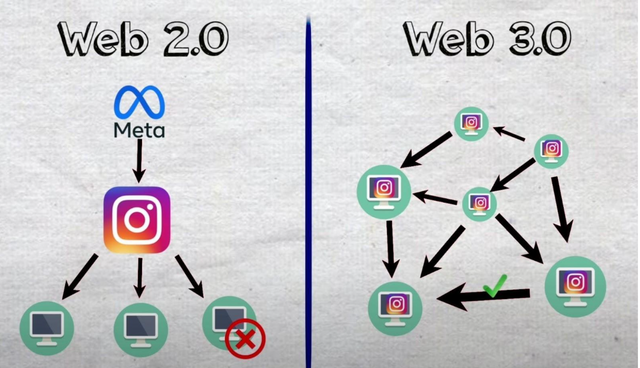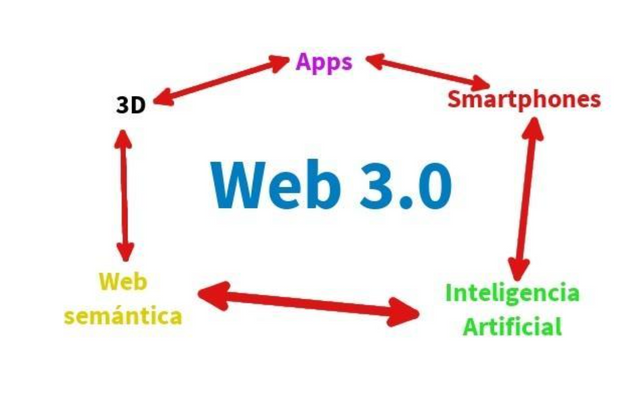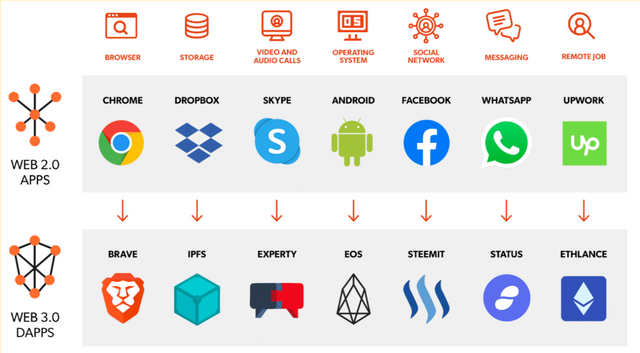"From Static to Dynamic: Embracing the Web 3.0 Paradigm Shift"

In today's fast-paced and competitive world, it's essential to stay up-to-date with the latest technological advancements. One of the most significant improvements in recent years is Web 3.0, which has gained widespread acceptance and become the industry standard due to its innovative technology. Businesses, both small and large, are now recognizing the advantages of transitioning from Web 2.0 to Web 3.0.
The estimated value of the worldwide Web 3.0 market is projected to reach $81.5 billion by 2030. Users believe that the decentralized infrastructure of Web 3.0 offers enhanced safety and transparency. Consequently, various groups and individuals are collaborating to develop Web 3.0 applications that are more user-friendly and transparent.
This blog post is intended to assist those who are seeking guidance on transitioning from Web 2.0 to Web 3.0. The article will outline the necessary steps that companies can take to make this transition.
Web 3.0

The semantic web is the central concept of Web 3.0, which is the third generation of the internet. Unlike traditional search engines that rely on keywords or numerical data, the semantic web employs AI to understand web content and absorb information in a manner similar to humans, rather than just following patterns like conventional machines. The primary goal of the semantic web is to facilitate the discovery, exchange, and integration of information, making it more accessible and user-friendly.
Web 3.0 is a newer version of the internet that aims to connect data in a decentralized manner. This is better than Web 2.0, where data is mainly stored in central locations. In Web 3.0, both users and machines can engage with the data in a more meaningful way. Programs will need to understand data not only conceptually but also contextually, allowing for a better understanding of the information.
Web 3.0 Infrastructure
Once you have built a Web 3.0, the next step is to set up a Web 3.0 infrastructure. This involves investing in blockchain technology, creating decentralized applications (DApps), and establishing a network of computers that can store and manage data in a distributed manner.
The Web 3.0 infrastructure should be created in a way that supports peer-to-peer transactions, enhances security and transparency, and improves the overall user experience. Additionally, businesses may need to work with other organizations to establish a more extensive, decentralized network that can meet their specific business needs.
Differences between Web 2.0 and Web 3.0
Web 2.0 refers to centralized platforms such as social media networks, e-commerce websites, and other web-based services that store and handle data on centralized servers. In contrast, Web 3.0 is decentralized, meaning that data is distributed across a network of computers instead of being stored on a single server.
Web 3.0 is the next generation of the internet, and it uses a technology called blockchain to make transactions more trustworthy and secure. With Web 3.0, people can directly transact with each other without the need for middlemen. Companies need to understand these differences so they can decide how to update their business models and technology to fit with Web 3.0.
With Web 2.0, user data is typically stored in large amounts on centralized servers, and companies like Google, Facebook, and Twitter act as guardians of that data. As a result, for the convenience of these services, users have to neglect information security. Whether they are aware of it or not, their identification, browser habits, searches, discussions, and online purchase information have all been sold to a third party.
Web 3.0 is different from Web 2.0 because it connects devices through a decentralized network instead of a central database on servers. During the Web 3.0 phase, there are some important features, such as the absence of third-party intermediaries between users. Additionally, Web 3.0 emphasizes maintaining data privacy and security and aims to provide uninterrupted service.
Benefits of Web 3.0
Web 3.0 is a significant upgrade from Web 2.0, and it offers many benefits such as increased security, transparency, and privacy. It also allows people to transact directly with each other without the involvement of intermediaries.
Businesses should carefully consider how these benefits can improve their operations, increase efficiency, and create opportunities for growth. Overall, Web 3.0 provides great advantages for both companies and users.
- Enhance Privacy:
Web 2.0 has a major issue with security, which has resulted in many digital dangers such as malware, DDoS attacks, and data breaches. These attacks can be very costly to businesses, with an average cost of millions of dollars depending on the industry.
For example, in July 2022, KeyBank customers had their personal data stolen by hackers through a third-party insurance vendor, resulting in $5 million worth of damages. This highlights the importance of extensive software testing to ensure the security policies and procedures of an organization and its suppliers are secure.
Web 3.0 is different because it has a decentralized structure and utilizes blockchain technology, which makes it much more difficult for hackers to access the network. This added layer of security is a significant advantage of Web 3.0.
- Individualized experience
Web 2.0 has a lot of ads that don't always match what users want, which can be annoying and push them away. But with Web 3.0, AI algorithms can figure out what users like and offer them personalized ads.
This makes it more likely that users will see ads they actually care about, which is better for everyone.
- Data Ownership
Many big companies like Facebook, Microsoft, and Amazon collect personal data from people and sell it to advertisers for a lot of money. But Web 3.0 is different from Web 2.0 because it let’s users take control of their own sensitive information.
This means that users get to decide who can see their information, instead of companies making those decisions for them.
- More efficient search
Today’s search engines are not always trustworthy and often don't give accurate results. But Web 3.0 is different because it has something called the semantic web. This means that instead of just looking for specific words, it focuses on the meaning of those words and the context in which they are used. This makes web pages more organized, which makes it easier for users to find the information they need.
- New Revenue Streams:
Web 3.0 could be a game-changer for businesses because it opens up new ways to make money. Companies can create decentralized apps and get involved in decentralized finance (DeFi) and other blockchain-based services.
This means that there are more opportunities for businesses to earn revenue and participate in a growing ecosystem.
Educate Employees and Customers
Companies need to invest in training and resources to help their employees understand the new technology and how it will impact their careers. They also need to communicate with clients about changes in their interactions with the company and explain how the decentralized internet will create new options for them.
By knowing the differences between Web 2.0 and Web 3.0, companies can make a successful transition to the decentralized Internet and benefit from its opportunities. This includes identifying the benefits of decentralized systems, developing a strategy for Web 3.0, building a Web 3.0 infrastructure, and educating employees and customers about the new technology.
Application of Transition from Web 2.0 to 3.0
Using blockchain technology can make the transition to Web 3.0 smoother for different applications. However, the way users connect to digital services is different with Web 3.0.
Manually signing and verifying transactions helps prevent platforms from taking personal data. To make this transition, Web 2.0 applications need to transform into Web 3.0 products that better serve users' needs.

Essentia and EOS are new online gateways that can be used in place of iOS and Android.
Instead of Google Drive or Dropbox, we use Storj, Siacoin, Filecoin, or IPFS to share and store files.
For video calling, Instead of Skype, we use Experty.io
Instead of WhatsApp and WeChat for messaging, we have status.
Ethlance might replace Upwork, Akasha or Steemit would play the role of Facebook, and Brave Browser would act as Chrome.
Here are some comprehensive side-by-side comparisons of apps from the two generations that show the impact of the transition.
- Android vs. Essentia. one
Essentia. one is a platform for developing, storing, accessing, and running decentralized applications. It provides users with complete control and ownership of their identities, data, wallets, and assets. Furthermore, they can effortlessly participate in DApps and decentralized web browsing from any location and on any device.
To access your decentralized and centralized accounts, unlike Android or iOS, you do not need to re-enter passwords, back up, or change devices. Having a seed gives you quick access to all of your important personal and business logins.
- Google Drive vs IPFS
Google Drive is now one of Google's most popular free storage services. Data kept on Google Drive is dependent on Google's servers, so data privacy and availability cannot be totally guaranteed because hackers can attack this service.
Meanwhile, the IPFS- InterPlanetary File System - is a content and identity-based data distribution protocol that enables users to transfer files peer-to-peer without the need for physical presence.
The user's uploaded content will be hashed and created as a code. IPFS eliminates duplication by returning the same hashes for the same material.
When a node's content is broken down into fragments, it is supplied to nodes nearby in the network. Having content stored in multiple nodes close to each other allows them to download faster, save bandwidth, and maintain data availability even if one or more nodes are attacked.
IFPS developed a decentralized network of nodes to eliminate the need for many docking stations and Internet servers, resulting in a significant reduction in overall expenses.
- Skype vs. Experty.io
Experty is an audio and video application that enables experts in the field to monetize their time and knowledge on the Ethereum blockchain. This application enables the cost-free monetization of audio and video calls by automating payment through a smart contract.
Similar to Skype, it allows people to exchange information. On the other hand, Experty's payment approach is more efficient when experts provide fee-based consultations. Experty will establish video calls between information sellers and buyers without involving a bank, and the price of the sale in exchange for information depends on the time of the call.
- WhatsApp vs. Status
As we know, Telegram and WhatsApp are popular options, both instant messaging programs are web 2.0-based, which poses significant security risks. To close this security gap, Web 3.0 introduces Status, which integrates cutting-edge blockchain technology with instant messaging.
Status is built on the Ethereum blockchain and based on Web 3.0, and it brings in a new era of decentralized instant messaging by enabling peer-to-peer, end-to-end encrypted communication instead of the traditional server-client model. Furthermore, it supports secure texting by offering users complete control over their information and the option of pseudo-anonymity.
- Chrome vs Brave
Chrome and Brave use chromium. While Chrome adds proprietary features to boost power, Brave is an open-source browser that improves privacy and security.
Brave bans third-party advertisements and cookies by default, unlike Chrome. Brave limits what Facebook, Google, and other ad networks may learn about browsing patterns.
Brave stores all browser data locally on the computer, which users can remove. Brave is the first all-in-one browser to allow Tor browsing.
Brave automatically encrypts webpage connections when possible (only HTTPS everywhere on Chrome).
User experience is Brave's weakness. Brave secures user data, unlike Chrome and its plugins, which improve online browsing. Syncing Brave on many devices is also inconvenient. Brave currently supports most Chrome add-ons.
If you don't need to browse odd websites, Chrome may be fine. If you value privacy, Brave is better.
Conclusion
Web 2.0 was the writable phase of the web, allowing users to communicate with each other and the website itself. The functional version of the web is called Web 3.0. In this case, computers can understand data just like humans can and create particular user content.
Simultaneous with the technological transition from Web 2.0 to Web 3.0 is the transformation of apps that can be used on those platforms.
In conclusion, transitioning from Web 2.0 to Web 3.0 is a big task, but the rewards are huge. Businesses can successfully migrate to the decentralized internet and take advantage of the new opportunities that it provides.
Would you like to be a part of the future of the Internet? The Web 3.0 revolution is here, and it's all about creating a more user-friendly and decentralized online world. How do you envision changing the way you connect, work together, and create in this exciting new era? Share your ideas.